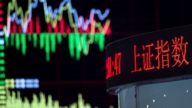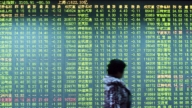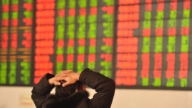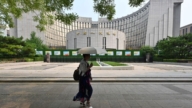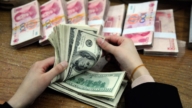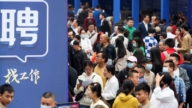【新唐人2012年12月01日訊】中共國務院副總理李克強,最近在中南海會見訪華的「世界銀行」行長金墉,他表示,中國已進入「中等收入國家」行列,未來中國必須跨越「中等收入陷阱」。但有專家認為,實際上中國距離「中等收入國家」行列越來越遠。我們來聽聽專家們的分析。
所謂「中等收入陷阱」,是指新興國家人均年收入達到3000美元水平時,積聚的矛盾集中爆發,經濟增長因發展戰略失誤、或受外部衝擊「回落」或「長期停滯」。那麼,據「世界銀行」統計,中國現時人均年收入為5400美元,已屬於中高等收入國家(人均收入約3800至11900美元)。
因此,國務院副總理李克強向「世銀」行長金墉表示,中國必須依靠國際視野和世界經驗以跨越「中等收入陷阱」。
但是,純粹依據中共當局提出的國民生產總值(GDP)數據和國民收入數據,來做分析和判定中國已經屬於「中等收入國家」,令專家質疑。
美國「南卡羅萊納大學」艾肯商學院教授謝田指出,李克強當年擔任遼寧省委書記時,就曾親自告訴美國大使,他不相信中國GDP的數字。李克強說,他自己通過發電、貸款、鐵路運輸的數字,來估計遼寧省的GDP數字。
「美國南卡羅萊納大學」艾肯商學院教授謝田:「實際上他完全知道中國這個GDP數字是假的。如果中國整體國民經濟最根本的數字都是假的,那這個國民收入數字一定是假的,一定是不可靠的。所以,依這個來作為依據,來判定中國已經進入中等收入國家,這我覺得是非常荒唐的。」
美國「普林斯頓大學」社會學博士,旅美中國經濟社會學者程曉農也指出,目前,中國確實掉進了「陷阱」。但並非「中等收入陷阱」,而是收入分配不公造成的,可謂「經濟增長困境」的陷阱。
旅美中國經濟社會學者程曉農:「就是說,中國現在按人均GDP來講,也許勉強算是中等收入國家。但是,一個很奇怪的現象,是全世界從來沒有過的﹔就是,中等收入國家的特點應該是國民的消費和經濟增長同步,但中國正好相反,消費在萎縮,而經濟增長受益的不是國民,而是政府。」
據了解,1990年代,大陸國民消費平均佔GDP的46%,但從2000年開始,這個比例迅速下滑,2010年降到約35%。程曉農分析,中國經濟快速增長,但國民的消費佔整個GDP的比重,卻迅速萎縮,這在世界各國中是少有的現象。
程曉農:「經濟增長的同時,大部分民眾的國民所得並沒有提高,所以消費力道迅速的相對萎縮。5%—10%的人,占有了整個經濟成長絕大部分成果,而普通老百姓得不到任何好處,這就造成了一個很大的陷阱。擁有差不多十四億人口的世界上最大的國家,它的消費不足以支撐這個國家的經濟成長。」
近年來,中共總理溫家寶曾多次談論,中國的經濟無法實現所謂的「可持續增長」問題。程曉農指出,即將上任擔任總理的李克強,顯然並沒有充分理解溫家寶面臨的困境﹔或者,不能提出任何有效改善這種「收入分配結構」的辦法,因為它和「政治結構」息息相關。
程曉農:「就是說,如果這個統治集團的群體,能夠無條件的占有整個經濟成長的成果,那麼無論經濟怎麼成長,好處都到不了老百姓手裡。實際上中國距離『中等收入』越來越遠。國民都能達到中等收入水平,這時候才談得到所謂『中等收入陷阱』,中國根本談不上!」
程曉農分析,如果這個態勢不轉變,中國經濟增長越快,老百姓的收入、消費的比例,下降的也越快。
採訪編輯/梁欣 後製/孫寧
Experts: China Has Pulled Farther away from
“Middle-Income” Level
Vice Premier Li Keqiang of the Chinese Communist Party
(CCP) recently met with World Bank President Jim Yong Kim in Beijing.
Li said China has entered the ranks of
middle-income countries.
In the near future, China needs to skip the
“middle-income trap".
Experts say that in reality, China has increasingly
detached from the level of the “middle-income” countries.
The “Middle Income Trap" occurs when developing countries
Attain the level of US$3,000 per capita income,
its growth plateaus and eventually stagnates at that level.
World Bank’s data show that China’s current per capita
annual income is US$ 5,400.
And that China enters a tier of upper-middle-income country
(GNI per capita is US$ 3,800 to US$11,900).
Therefore, Li Keqiang said to Jim Yong Kim that
China must cross the “middle-income trap" by using worldwide experience for reference.
China’s entry into group of middle-income country was judged
on the basis of CCP official data on GDP and national income.
This conclusion has been questioned by experts.
Xie Tian, professor, Business School,
Univ. of South Carolina, says that
Li Keqiang, when serving as Liaoning’s Party chief,
told an American ambassador that he did not believe China’s GDP measure.
Li said that he used statistics of electricity production,
bank loans and freight transportation volume to estimate local GDP figures.
Xie Tian: “He fully knows the official GDP figures are
unreliable.
If such basic data in terms of China’s national economy is
inaccurate, the data on national income is certainly unreliable.
So it’s ludicrous to use these false figures to make a
conclusion that China is entering the ranking of middle-income countries.”
U.S.-based economist Dr. Cheng Xiaonong thinks that
China has fallen into a “trap”, but not the “middle-income trap".
It is a trap of “economic growth plight”, a result of unfair
distribution of income and wealth.
Cheng Xiaonong: “In terms of per capita income,
China may barely claim to be a middle-income country.
But it has a very weird fact which cannot be found
anywhere in the world.
In a middle-income country, its national consumption
always keeps pace with its economic growth.
But it’s just the opposite in China,
where consumption is shrinking.
However, the beneficiary of its economic growth is not
the populace, but the government.”
Reportedly, in the 1990s, China’s national consumption
accounted for 46% of GDP.
However, since 2000, the percentage has plunged,
and in 2010, it was down to 35%.
Cheng Xiaonong points out that this is a rare phenomenon
in the world.
That is, China’s rapid economic growth was accompanied
by a sharp fall of national consumption as a share of GDP.
Cheng Xiaonong: “The outward economic growth didn’t
improve most of civilians’ income.
So their consumption fell off. The vast majority of
economic growth is controlled by only 5%-10% of Chinese.
This has created a large trap in reality.
In a country with the largest population of nearly 1.4 billion,
consumption capability can’t support economic growth.”
In recent years, CCP premier Wen Jiabao has repeatedly
said that China’s economy cannot realize a “sustainable growth".
Cheng Xiaonong thinks that Li Keqiang, set to be new
premier, apparently has not yet fully discerned the plight that Wen faces.
Or, Li has not yet found any solution to ameliorate the existing
“structure of income distribution”.
This is because it is closely linked to the CCP’s
“political structure”.
Cheng Xiaonong: “That is to say, when this ruling elite group
can hold unconditionally all the fruits of the economy growth,
civilians would benefit nothing no matter
how the economy grows.
This actually pulls China farther away from the
“middle-income” level.
The basic premise of the so-called “middle-income trap" is
that citizens have all reached the middle-income level.
Now, China is simply too far from that ! “
Cheng Xiaonong warns that if this situation remains
unchanged, the faster the economy grows,
the quicker the civilian income and consumption
as a share of GDP will drop.


